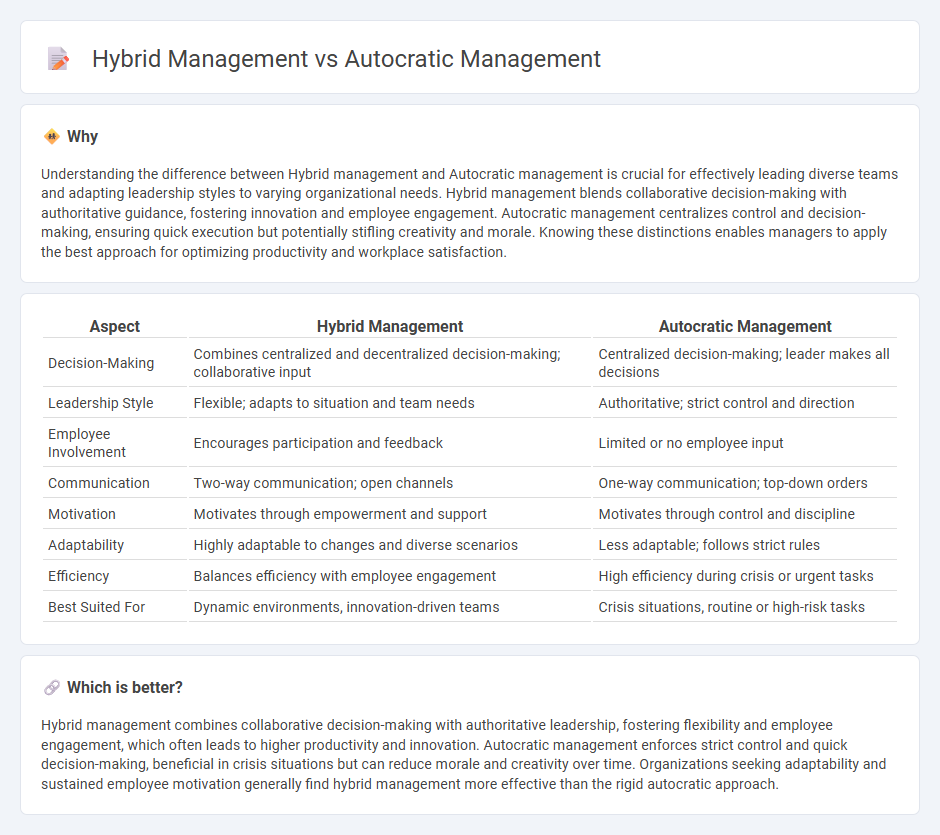
Hybrid management combines the collaborative decision-making of participative styles with the directive clarity of autocratic leadership, enhancing flexibility and team engagement. Autocratic management centralizes authority, enabling swift decisions but often limiting employee input and innovation. Explore the nuances and impacts of these management styles to determine the best fit for your organizational needs.
Why it is important
Understanding the difference between Hybrid management and Autocratic management is crucial for effectively leading diverse teams and adapting leadership styles to varying organizational needs. Hybrid management blends collaborative decision-making with authoritative guidance, fostering innovation and employee engagement. Autocratic management centralizes control and decision-making, ensuring quick execution but potentially stifling creativity and morale. Knowing these distinctions enables managers to apply the best approach for optimizing productivity and workplace satisfaction.
Comparison Table
| Aspect | Hybrid Management | Autocratic Management |
|---|---|---|
| Decision-Making | Combines centralized and decentralized decision-making; collaborative input | Centralized decision-making; leader makes all decisions |
| Leadership Style | Flexible; adapts to situation and team needs | Authoritative; strict control and direction |
| Employee Involvement | Encourages participation and feedback | Limited or no employee input |
| Communication | Two-way communication; open channels | One-way communication; top-down orders |
| Motivation | Motivates through empowerment and support | Motivates through control and discipline |
| Adaptability | Highly adaptable to changes and diverse scenarios | Less adaptable; follows strict rules |
| Efficiency | Balances efficiency with employee engagement | High efficiency during crisis or urgent tasks |
| Best Suited For | Dynamic environments, innovation-driven teams | Crisis situations, routine or high-risk tasks |
Which is better?
Hybrid management combines collaborative decision-making with authoritative leadership, fostering flexibility and employee engagement, which often leads to higher productivity and innovation. Autocratic management enforces strict control and quick decision-making, beneficial in crisis situations but can reduce morale and creativity over time. Organizations seeking adaptability and sustained employee motivation generally find hybrid management more effective than the rigid autocratic approach.
Connection
Hybrid management combines elements of autocratic management by integrating authoritative decision-making with collaborative approaches to optimize efficiency and employee engagement. Autocratic management provides clear direction and control, which in hybrid models helps maintain structure while allowing flexibility through participative elements. This connection enables organizations to balance strict leadership with adaptability, enhancing overall management effectiveness.
Key Terms
Decision-making authority
Autocratic management centralizes decision-making authority in the hands of a single leader, ensuring quick decisions but limiting employee input and creativity. Hybrid management distributes decision-making power across multiple levels, balancing control with collaborative input to enhance innovation and adaptability. Explore further to understand which decision-making structure best suits your organizational goals.
Leadership flexibility
Autocratic management centralizes decision-making authority, limiting leadership flexibility and often resulting in rigid organizational structures. Hybrid management blends autocratic and democratic styles, enhancing adaptability by allowing leaders to shift between directive and participative approaches depending on situational demands. Explore how leadership flexibility in hybrid management can improve team performance and organizational resilience.
Employee involvement
Autocratic management centralizes decision-making authority with minimal employee involvement, often resulting in limited feedback and reduced creativity. Hybrid management blends autocratic control with participative approaches, encouraging employee input in key decisions to enhance motivation and innovation. Explore how varying degrees of employee involvement impact organizational performance in different management styles.
Source and External Links
Autocratic Leadership: Definition & Examples - AIHR - Autocratic leadership is a management style where decision-making power is concentrated in one leader who makes decisions independently and expects strict obedience from subordinates, with limited input from team members and a strong focus on discipline and control.
Autocratic Leadership: Definition, Benefits, and Examples - Autocratic leadership centralizes power with one leader who directs work and defines policy without subordinate input, often applying strict rules and expecting compliance, making it effective in some organizations but highly controlling.
What Is Autocratic Leadership? | Rasmussen University - Autocratic leadership is a style where a dominant leader believes they know best and makes all decisions alone, discouraging feedback, creativity, and collaboration while emphasizing rules, procedures, and loyalty to their vision.
 dowidth.com
dowidth.com